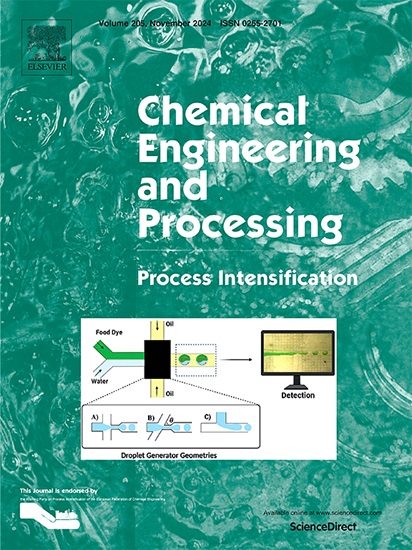带结构电极的旋流电化学反应器在单相和两相(气相)流动下的传质研究
IF 3.8
3区 工程技术
Q3 ENERGY & FUELS
Chemical Engineering and Processing - Process Intensification
Pub Date : 2025-03-20
DOI:10.1016/j.cep.2025.110286
引用次数: 0
摘要
分析了两种结构作为反电极对电化学反应器旋流传质性能的影响。用作对电极的排列方式要么是螺旋形结构,要么是膨胀的金属片。与衰减旋流系统相比,前者具有更均匀的传质分布。当反应器长度为257.5 mm时,螺旋匝数大于9时,均匀性最佳。后一种结构对电极具有较高的比表面积,提高了反应器的时空产率,但在衰减旋流的传质性能方面表现不佳。体积流量对两种结构对电极传质分布的影响都不大。与单相情况相比,两相系统的操作显示出稍微无效的行为。从传质分布的角度来看,螺旋结构作为对电极的使用改善了反应器在旋流条件下的性能。本文章由计算机程序翻译,如有差异,请以英文原文为准。

Mass-transfer study in a swirling flow electrochemical reactor with structured counter electrodes under single-phase and two-phase (gas-evolving) flows
This paper analyses the effect of two kinds of structures as counter electrodes on the mass-transfer performance of an electrochemical reactor under swirling flow. The arrangements used as counter electrodes were either helical-shaped structures or an expanded metal sheet. The former presents a more uniform mass-transfer distribution as the main advantage compared to a decaying swirling flow system. The best uniformity was achieved when the number of turns in the helix was higher than 9 for a 257.5 mm reactor length. The latter structured counter electrode can only be vindicated by its high value of specific surface area, increasing the space-time yield of the reactor, but with a poor performance in the mass-transfer behaviour regarding the decaying swirling flow. The effect of the volumetric flow rate on the mass-transfer distribution is scarce for both structured counter electrodes. The operation with a two-phase system showed a slightly more ineffective behaviour in comparison to the single-phase case. The use of a helical structure as a counter electrode can be recognised as an improvement in the reactor performance under swirling flow from the standpoint of the mass-transfer distribution.
求助全文
通过发布文献求助,成功后即可免费获取论文全文。
去求助
来源期刊
CiteScore
7.80
自引率
9.30%
发文量
408
审稿时长
49 days
期刊介绍:
Chemical Engineering and Processing: Process Intensification is intended for practicing researchers in industry and academia, working in the field of Process Engineering and related to the subject of Process Intensification.Articles published in the Journal demonstrate how novel discoveries, developments and theories in the field of Process Engineering and in particular Process Intensification may be used for analysis and design of innovative equipment and processing methods with substantially improved sustainability, efficiency and environmental performance.

 求助内容:
求助内容: 应助结果提醒方式:
应助结果提醒方式:


